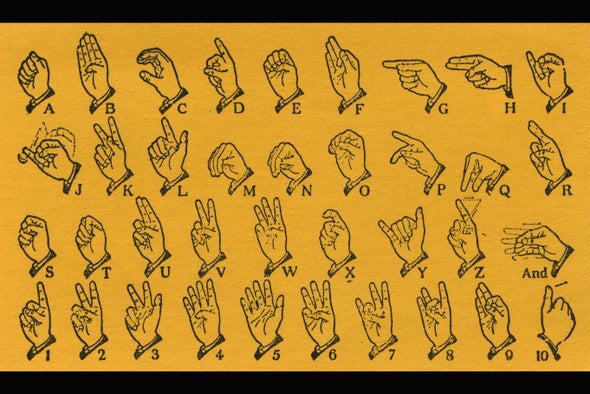(单词翻译:单击)
听力文本
This is Scientific American's 60-second Science, I'm Susanne Bard.
More than 140 sign languages are used today, primarily by deaf communities around the world. Like spoken languages, each sign language has its own grammar, vocabulary and other special features.
For example, American Sign Language and British Sign Language are mutually unintelligible. In fact, American Sign Language has more in common with French Sign Language, largely because French educators were instrumental in helping get deaf schools established in the United States during the 19th century. But while the lineages and development of spoken languages are well-studied...
"There haven't been a lot of large-scale comparisons of sign languages."
University of Texas, Austin linguist Justin Power. He and his colleagues aim to address that information gap.
"In order to study the question of sign language evolution, we first assembled a database of manual alphabets from dozens of different sign languages around the world. So a manual alphabet is sort of a subsystem within a sign language that is used to represent a written language. So there's a hand shape that corresponds to each letter."
Power's team chose to study manual alphabets because a record of them exists going back to the late 16th century in Europe. To uncover relationships between the alphabets, the researchers used the same methods that biologists use to trace relationships between different species, based on their DNA.
"The methods grouped sign languages in this study into five main European lineages. And those were Austrian origin, British origin, French origin, Spanish and Swedish."

Power says manual alphabets from Austria, France and Spain could be traced back to one-handed manual alphabets from 16th- and 17th-century Spain. But each of those lineages evolved independently of each other. And the British lineage, which uses a two-handed manual alphabet, eventually made it to Australia, New Zealand and India.
The study also confirmed the French origins of American Sign Language and those of other countries, including Mexico, Brazil and the Netherlands.
Surprisingly, the Austrian manual alphabet influenced sign languages as far away as Russia. But while this lineage has largely died out, remnants of it live on in Icelandic Sign Language today.
The study is in the journal Royal Society Open Science.
Power says future research comparing the vocabularies of different sign languages could provide even more clues about how they've changed over time.
"Understanding how sign languages evolve would tell us a lot about the way that language, in general, evolves."
Thanks for listening for Scientific American's 60-second Science. I'm Susanne Bard.
参考译文
这里是科学美国人——60秒科学系列,我是苏珊娜·巴德。
现在全世界使用的手语有140多种,使用者主要是失聪群体。和口语一样,每种手语都有自己的语法、词汇和其它特殊特征。
例如,美国手语和英国手语互不相通。事实上,美国手语与法语手语的共同点更多,主要原因是法国教育者在美国19世纪建立聋人学校时提供了帮助。但是,虽然口语的世系和发展得到了充分的研究……
“但手语的大规模比较研究进行得并不多。”
得克萨斯大学奥斯汀分校的语言学家贾斯汀·鲍尔说到。他和同事旨在解决这个信息差。
“为了研究手语进化问题,我们首先将全世界几十种手语的手语字母编成数据库。手语字母是符号语言中的子系统,而符号语言用于代表书面语言。因此每个字母都有对应的手势。”
鲍尔的团队选择研究手语字母,是因为欧洲有一份可追溯到16世纪晚期的记录。为了揭开字母之间的关系,研究人员借用了生物学家的方法——根据DNA追踪不同种类间的关系。
“这些方法将该研究中的手语分为欧洲五大世系。分别是奥地利世系,英国世系,法国世系,西班牙世系和瑞典世系。”
鲍尔表示,奥地利、法国和西班牙世系中的手语字母可追溯到16世纪和17世纪西班牙的单手手语字母。但每个世系都是独立演化的。而使用双手手语字母的英国世系,最终传到了澳大利亚、新西兰和印度。
这项研究还证实了美国手语以及墨西哥、巴西和荷兰等国的手语均起源于法国。
令人惊讶的是,奥地利手语字母的影响远至俄罗斯。但是,虽然这一世系已基本绝迹,但其残余部分至今仍留存在冰岛手语中。
这项研究发表在《英国皇家学会·开放科学》期刊上。
鲍尔表示,未来对不同手语词汇的比较研究可以提供更多线索,让我们了解手语如何随时间而变化。
“了解手语的演化方式,我们就可以更加清楚地了解语言整体进化的方式。”
谢谢大家收听科学美国人——60秒科学。我是苏珊娜·巴德。
译文为可可英语翻译,未经授权请勿转载!
重点讲解
重点讲解:
1. be instrumental in 有助益的;有帮助的;起作用的;
In his first years as chairman he was instrumental in raising the company's wider profile.
他任董事长的最初几年为提升公司的知名度起到了积极的推动作用。
2. in order to 为了;以便;目的在于;
In order to get a complete picture, further information is needed.
为掌握全面情况,还需要详细资料。
3. go back to 追溯到;回溯到;
The feud with the Catholics goes back to the 11th century.
与天主教的夙怨可以追溯到11世纪。
4. die out 逐渐消亡;灭绝;绝种;
I want to teach Irish so that it won't die out.
我想教爱尔兰语,这样它就不会彻底消失。


